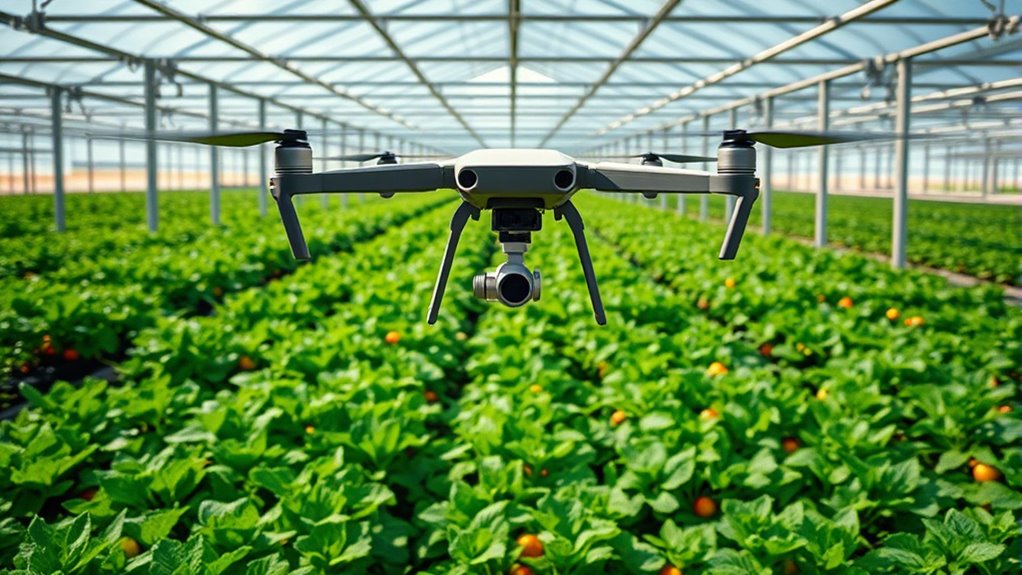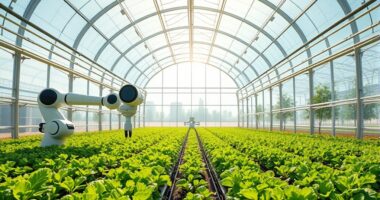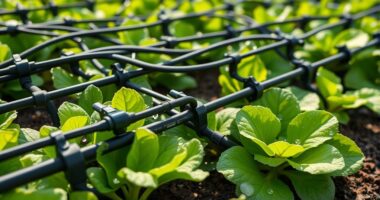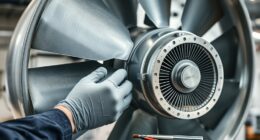Drones are transforming crop health analysis in greenhouses by providing real-time, high-resolution data that helps you spot issues early. With advanced sensors and imaging, you can detect pests, nutrient deficiencies, and other problems before they become severe. This enables targeted treatments and precise actions, reducing waste and improving yields. Their ability to cover large areas quickly makes your management more efficient. Explore how drone technology can boost your greenhouse productivity and efficiency by continuing further.
Key Takeaways
- Drones enable real-time, high-resolution monitoring of greenhouse crops, facilitating early detection of pests and nutrient deficiencies.
- Advanced imaging sensors help identify plant health issues before visible symptoms appear, supporting precise interventions.
- Regular drone flights provide continuous data collection for trend analysis, optimizing crop management decisions.
- Non-intrusive aerial assessments reduce plant disturbance and improve monitoring efficiency over manual inspections.
- Drone technology promotes sustainable practices by enabling targeted treatment, resource efficiency, and organic crop management.

Drones are transforming how greenhouses monitor crop health by providing real-time, high-resolution data that was previously difficult to obtain. With their advanced sensors and imaging capabilities, you can now quickly identify issues like pest detection and nutrient monitoring, enabling more targeted and effective interventions. Instead of relying solely on manual inspections, which can be time-consuming and sometimes miss early signs of trouble, drones give you an all-encompassing view of your greenhouse environment from above. This allows you to detect pests early, preventing infestations from spreading widely and damaging your crops. High-resolution cameras can pick up subtle signs of pest activity, such as discoloration or unusual leaf damage, so you can act swiftly before the problem escalates.
Drones offer real-time, high-resolution crop monitoring to detect pests early and prevent widespread damage.
Nutrient monitoring is another critical aspect that drones augment in greenhouse management. By capturing multispectral and thermal images, you gain insights into plant health and nutrient deficiencies. For example, drones can identify areas where crops are underperforming due to lack of essential nutrients, helping you adjust fertilization strategies accurately. This exact data reduces waste and ensures that each section of your greenhouse receives the precise nutrients needed, promoting uniform growth and higher yields. The ability to monitor nutrient levels dynamically means you can respond to changes in plant health without waiting for visual symptoms to appear, saving time and resources.
Using drones for pest detection and nutrient monitoring also streamlines your overall crop management process. You can schedule regular flights to scan the entire greenhouse, creating a continuous monitoring system that keeps you informed about the status of your crops. The data collected can be integrated into your management software, allowing you to analyze trends over time and make data-driven decisions. This proactive approach minimizes crop losses and improves productivity because you’re addressing issues before they become severe.
Furthermore, drones reduce the need for invasive inspections, which can disturb plants and introduce risks of spreading pests or diseases. Instead, you get a non-intrusive, quick assessment that can be repeated as often as necessary. This agility is especially valuable in large or complex greenhouses, where manual inspections might be impractical or incomplete. By harnessing drone technology, you’re not only enhancing pest detection and nutrient monitoring but also optimizing your entire crop management system, leading to healthier plants, higher yields, and more efficient resource use. Additionally, integrating organic techniques such as cover crops and compost can further enhance the sustainability of your crop health management practices.
Frequently Asked Questions
What Are the Legal Regulations for Drone Use in Greenhouses?
You need to guarantee legal compliance and understand regulatory oversight when using drones in greenhouses. Check local laws, as regulations vary by region, and obtain necessary permits or licenses. Always fly within designated areas, avoid privacy violations, and follow safety guidelines. Staying informed about updates in drone regulations helps you operate responsibly, preventing legal issues and ensuring your drone activities align with current legal standards.
How Do Drones Perform in Small, Enclosed Greenhouse Spaces?
In small, enclosed greenhouses, drones perform well thanks to indoor navigation systems that help them maneuver tight spaces. Their obstacle detection capabilities allow you to avoid plants and structures, ensuring safe operation. You’ll find that with proper calibration, drones can efficiently scan and analyze crop health in confined areas, providing quick, accurate data without risking damage or interruption. This makes them a valuable tool for indoor greenhouse management.
What Is the Cost Comparison Between Drone Technology and Traditional Methods?
Did you know that drone technology can reduce crop monitoring costs by up to 30%? In your cost analysis, you’ll find that drones have higher upfront equipment expenses but lower ongoing labor costs. Traditional methods often involve manual inspections, which are time-consuming and labor-intensive. Over time, drones prove more cost-effective, saving you money while providing quicker, more accurate crop health data.
How Do Drones Impact Plant Health and Safety?
Drones enhance plant health and safety by enabling precise plant monitoring, which helps you spot issues early. They reduce the need for manual inspections, lowering your risk of exposure to harmful pesticides during application. With targeted pesticide application, drones ensure only affected areas are treated, minimizing chemical use and potential harm. Overall, drones improve safety for your workers and promote healthier plants by providing accurate, timely data.
What Maintenance Is Required for Drones Used Indoors?
A stitch in time saves nine, so you should regularly check your indoor drone. You need to maintain the battery by charging it properly and avoiding over-discharge. Sensor calibration is essential to guarantee accurate crop health data, so perform calibration routines often. Keep blades clean and inspect for damage. Regular software updates also help keep your drone functioning smoothly and safely in the greenhouse environment.
Conclusion
Using drones for crop health analysis in greenhouses revolutionizes farming, allowing you to monitor plants quickly and accurately. Imagine identifying issues early, saving up to 20% of crop losses annually. With such technology, you can boost yields, reduce waste, and ensure healthier plants. Embrace this innovation to transform your greenhouse management and experience the future of agriculture today—because smarter farming signifies a more sustainable and prosperous tomorrow.









